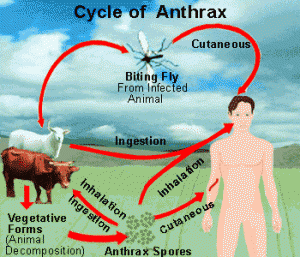A disease caused by a bacterium producing spores called 
Anthrax is usually contracted from animals, enters through open wound or inhalation of spores, but in 2001, it was used as a source of bioterrorism attack when anthrax was spread through the postal system. Letters were sent with powder containing anthrax, which caused at least 22 causes of anthrax infection, among which, five died.
Types and Causes of Anthrax
Anthrax cannot be transmitted from person to person. There are several ways of getting anthrax, depending on the type.
- Cutaneous (skin)
- Most common form of the disease and mildest
- Anthrax bacteria enter through a cut or sore in the skin
- Gastrointestinal (digestive)
- Eating undercooked meatfrom an infected animal
- Pulmonary(lungs)
- Spore inhalation
- Most deadly
- Once inhaled, will migrate to the chest’s lymph glands where they multiply, spread and produce toxins
Symptoms of Anthrax
There are three types of anthrax, each with different signs and symptoms. Symptoms begin to onset within a week after exposure to the bacteria
- Cutaneous
- Anelevated, itchy bump which may look like an insect bite that rapidly progresses into a painless sore with a black middle
- Swollen sore and lymph glands
- Gastrointestinal
- Nausea and vomiting
- Presence of blood in bacteria indicates that it is already in its later stages
- Nausea and vomiting
- Severe and bloody diarrhea
- Loss of appetite
- Sore throat
- Trouble swallowing
- Fever
- Swollen neck
- Pulmonary
- Symptoms resembling to flu, such as mild fever, sore throat, fatigue and muscle aches
- Moderate chest tightness
- As the disease develops:
- High-grade fever
- Breathing troubles
- Shock; and
- Meningitis
First Aid Management for Anthrax
Treatment for anthrax will vary on how it was acquired in the body. Any case of anthrax should be reported for better prognosis.
- Identify the source of anthrax and eliminate the source of infection.
- Cutaneous
- Antibiotics, such as penicillin, ciprofloxacin, erythromycin, etc. will suffice. Amoxicillin is typically used for children.
- To avoid cutaneous-acquired anthrax, always consistently clean an open wound and avoid areas where bacteria thrive.
- Gastrointestinal
- Antibiotics, such as penicillin, ciprofloxacin, erythromycin, etc. will suffice. Amoxicillin is typically used for children.
- To avoid acquiring anthrax through gastrointestinal means, buy only meat from clean and trusted suppliers. Also, proper handling and cooking of meat is strongly advised.
- Pulmonary
- A medical emergency
- Intravenous (IV) therapy with antibiotics is the usual treatment
- Unfortunately, there is no way to prevent inhalation of spores.
Although only some types of anthrax
are fatal, necessary treatment is still necessary to avoid complications, such as sepsis, etc. Join in workplace approved First Aid Courses to hone one’s skill in recognizing symptoms and learning how to prevent infections, such as in cases of anthrax and other bacterial contaminations.
